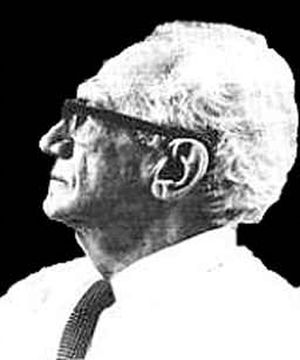Predictions by Immanuel Velikovsky (he also called them “prognostications” or “advanced claims”) have been claimed as successful vindications by the writer and others. They have been criticized by his detractors for being vague or unscientific.
Example criticism
Sagan (1977)
In Scientists Confront Velikovsky (1977), scientist Carl Sagan wrote :
“We will also examine an occasional additional “prediction” of Velikovsky – for example, that the Martian polar caps are carbon or carbohydrates. My conclusion will be that where Velikovsky is original he is very likely wrong; and that where he is right the idea has been pre-empted by earlier workers. There are also a large number of cases (see the epigraphs of this article) where he is neither right nor original. ..
“To the best of my knowledge, there is not a single astronomical prediction correctly made in Worlds in Collision with sufficient precision for it to be more than a vague lucky guess; and there are, as I have tried to point out, a host of claims made which are demonstrably false. The existence of strong radio emission from Jupiter is sometimes pointed to as the most striking example of a correct prediction by Velikovsky; but all objects give off radio waves if they are at temperatures above absolute zero. The essential character of the Jovian radio emission – that it is nonthermal, polarized, intermittent radiation, connected with the vast belts of charged particles which surround Jupiter, trapped by its strong magnetic field – are nowhere predicted by Velikovsky. Indeed, his “prediction” is clearly not linked in its essentials to the fundamental Velikovskian theses.””[1]Carl Sagan, “An Analysis of Worlds in Collision” in Donald W. Goldsmith (Editor), Scientists Confront Velikovsky (1977), Cornell University Press, ISBN 0801409616, ISBN-13 978-0801409615
Example acknowledgements
Bargmann and Motz (1962)
In 1962, Science magazine published a letter from Prof. Valentine Bargmann and Lloyd Motz “On the Recent Discoveries Concerning Jupiter and Venus“:[2]V. Bargmann, Lloyd Motz, “On the Recent Discoveries Concerning Jupiter and Venus“, Science’, December 21, 1962, Vol. 138, pp. 1350-52 acknowledging Velikovsky’s predictions on radio noises from Jupiter, and the heat of Venus.
Prof. Harry Hess (1963)
In 1963, Professor H. H. Hess, then Chairman of the Space Board of the National Academy of Science, wrote to Velikovsky:
“We are philosophically miles apart because basically we do not accept each other’s form of reasoning — logic. I am of course quite convinced of your sincerity and I also admire the vast fund of information which you have painstakingly acquired over the years.
“I am not about to be converted to your form of reasoning though it certainly has had successes. You have after all predicted that Jupiter would be a source of radio noise, that Venus would have a high surface temperature, that the sun and bodies of the solar system would have large electrical charges and several other such predictions. Some of these predictions were said to be impossible when you made them. All of them were predicted long before proof that they were correct came to hand. Conversely I do not know of any specific prediction you made that has since been proven to be false. I suspect the merit lies in that you have a good basic background in the natural sciences and you are quite uninhibited by the prejudices and probability taboos which confine the thinking of most of us.
“Whether you are right or wrong I believe you deserve a fair hearing.”[3]Letter March 15, 1963, “H.H. Hess to Velikovsky” at the Velikovsky Archive
Discussion
In 1977, Kronos journal published the following:[4]Kronos Vol. III No. 2 (Winter 1977) “Velikovsky and Establishment Science“
Select Bibliography of Velikovsky’s Prognostications
- Earth in Upheaval (N. Y., 1955), “Supplement”.
- The American Behavioral Scientist, “The Politics of Science and Dr. Velikovsky,” (Vol. VII, No. I, September, 1963), pp. 38-42.
- The American Behavioral Scientist (October, 1964), p. 15, n. 21.
- The Velikovsky Affair (New Hyde Park, 1966), pp. 233-249.
- Yale Scientific Magazine, “Venus — A Youthful Planet,” (April, 1967), pp. 8-11.
- Pensée I, “A Record of Success,” (May, 1972), pp. 11ff.
- Pensée II, “H. H. Hess and My Memoranda,” (Fall, 1972), pp. 27-28.
- Kronos I:3, “A Youthful Venus,” pp. 85-86; “Argon on Mars,” pp. 88-90 (November, 1975).
- Kronos I:4, “Cataclysmic Evolution,” pp. 98-110 (April, 1976).
- Kronos II:1, “New Light on Venus,” pp. 104-105; “The Martian Atmosphere,” pp. 105-109 (August, 1976).
- The Age of Velikovsky (Glassboro and Fort Worth, 1976).
- Kronos II:3, “The Sun’s Magnetic Field,” pp. 78-80 (February, 1977).
- Kronos III:I, “On the Advance Claim of Jupiter’s Radionoises,” pp. 27-30 (August, 1977).
- Kronos III:I, “L. Sprague de Camp: Anatomy of a Zetetic,” pp. 45-67 (August, 1977).
- Test of Time by Immanuel Velikovsky (unpublished manuscript detailing correct prognostications).
References
| 1. | ↑ | Carl Sagan, “An Analysis of Worlds in Collision” in Donald W. Goldsmith (Editor), Scientists Confront Velikovsky (1977), Cornell University Press, ISBN 0801409616, ISBN-13 978-0801409615 |
| 2. | ↑ | V. Bargmann, Lloyd Motz, “On the Recent Discoveries Concerning Jupiter and Venus“, Science’, December 21, 1962, Vol. 138, pp. 1350-52 |
| 3. | ↑ | Letter March 15, 1963, “H.H. Hess to Velikovsky” at the Velikovsky Archive |
| 4. | ↑ | Kronos Vol. III No. 2 (Winter 1977) “Velikovsky and Establishment Science“ |
